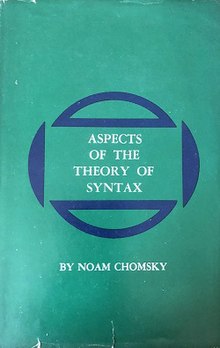Aspects of the Theory of Syntax

First edition
|
|
| Author | Noam Chomsky |
|---|---|
| Language | English |
| Subject | Natural language syntax |
| Publisher | MIT Press |
|
Publication date
|
May 1965 |
| Pages | 261 |
| Preceded by | Syntactic Structures |
| Followed by | Cartesian linguistics |
Aspects of the Theory of Syntax (known in linguistic circles simply as Aspects) is a book on linguistics written by American linguist Noam Chomsky, first published in 1965. In Aspects, Chomsky presented a deeper, more extensive reformulation of transformational generative grammar (TGG), a new kind of syntactic theory that he had introduced in the 1950s with the publication of his first book, Syntactic Structures. Aspects is widely considered to be the foundational document and a proper book-length articulation of Chomskyan theoretical framework of linguistics. It presented Chomsky's epistemological assumptions with a view to establishing linguistic theory-making as a formal (i.e. based on the manipulation of symbols and rules) discipline comparable to physical sciences, i.e. a domain of inquiry well-defined in its nature and scope. From a philosophical perspective, it directed mainstream linguistic research away from behaviorism, constructivism, empiricism and structuralism and towards mentalism, nativism, rationalism and generativism, respectively, taking as its main object of study the abstract, inner workings of the human mind related to language acquisition and production.
After the publication of Chomsky's Syntactic Structures, the nature of linguistic research began to change, especially at MIT and elsewhere in the linguistic community where TGG had a favorable reception. Morris Halle, a student of Roman Jacobson and a colleague of Chomsky at MIT's Research Laboratory of Electronics (RLE), was a strong supporter of Chomsky's ideas of TGG. At first Halle worked on a generative phonology of Russian and published his work in 1959. From 1956 until 1968, together with Chomsky (and also with Fred Lukoff initially), Halle developed a new theory of phonology called generative phonology. Their collaboration culminated with the publication of The Sound Pattern of English in 1968. Robert Lees, a linguist of the traditional structuralist school, went to MIT in 1956 to work in the mechanical translation project at RLE, but became convinced by Chomsky's TGG approach and went on to publish, in 1960, probably the very first book of a linguistic analysis based on TGG entitled The Grammar of English Nominalizations. This work was preceded by Lees's doctoral thesis on the same topic, for which he was given a Ph.D. in electrical engineering. Lees was technically the first student of the new TGG paradigm. Edward S. Klima, a graduate of the Masters program from Harvard and hired by Chomsky at RLE in 1957, produced pioneering TGG-based work on negation. In 1959, Chomsky wrote a critical review of B. F. Skinner's Verbal Behavior (1957) in the journal Language, in which he emphasized on the fundamentally human characteristic of verbal creativity, which is present even in very young children, and rejected the behaviorist way of describing language in ambiguous terms such as "stimulus," "response," "habit," "conditioning," and "reinforcement."
...
Wikipedia
